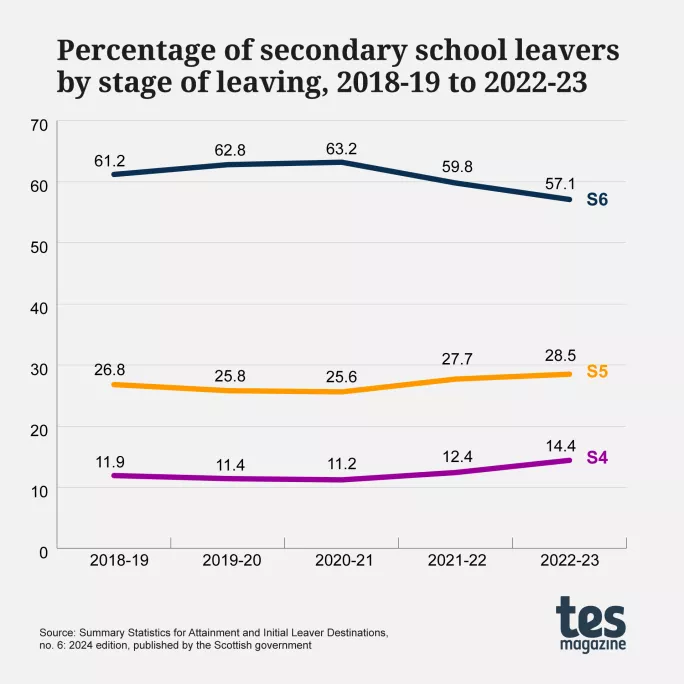Why are more Scottish students leaving school after S4?

More than 14 per cent of Scotland’s school leavers last year left in S4 - the highest proportion since 2010-11.
Official figures on school-leaver destinations, out today, show that this is the second year in a row that the proportion of school leavers in S6 has fallen, and the proportions in S4 and S5 have increased.
Last year brought the biggest S4 leaver cohort in Scotland since 2009-10, with 7,890 students leaving school at that age and stage - an increase of 1,027 students on the previous year.
In 2009-10, 8,862 students left school in S4 ,which equated to 16.7 per cent of the leavers that year.
The graph below shows how the leaver cohort has changed over time, between 2018-19 and 2022-23.

Keeping students in school for longer is generally celebrated, given that this is associated with higher attainment.
Today’s report, Summary Statistics for Attainment and Initial Leaver Destinations, points out that the larger proportion of S4 and S5 students leaving school in 2022-23 may have an effect on attainment for that cohort because pupils who leave school earlier generally have worse qualifications.
As the report highlights, “it is unlikely that an individual would be able to achieve a qualification at SCQF level 7 if they were an S4 leaver”.
And the figures do show a dip in attainment.
The proportion of school leavers with at least one national qualification at SCQF level 6 (so Higher or equivalent) was 57.9 per cent last year, compared with 61.3 per cent the previous year and 66 per cent in 2020-21. In 2018-19, the last year before the pandemic hit, 60.5 per cent of school leavers had at least one Higher.
- Also today: Budget cuts risk bringing schools to “tipping point”, says AHDS
- Budget cuts: Glasgow cuts could lead to loss of 450 teaching jobs
- Behaviour: Serious disruptive behaviour rising in Scottish schools
- Additional support needs: “Explosion” in ASN numbers sees schools struggling
Today the Scottish Liberal Democrats are also highlighting that the figures show the Scottish government is “not making a dent” in closing the disadvantage-related attainment gap for those leaving school.
Among those with one pass or more at SCQF level 5 or better (equivalent to National 5), the attainment gap remains unchanged between 2018-19 and 2022-23, at 22.3 percentage points.
Among those with one pass or more at SCQF level 6 or better, the attainment gap widened between 2018-19 and 2022-23, from 35.8 percentage points to 36.9 percentage points.
Students leaving school earlier
Willie Rennie, the Liberal Democrats’ education spokesperson, said that teachers identify “a series of roadblocks” when it comes to improving attainment, including behaviour, absence rates, lack of support for additional needs and unmanageable workloads - all of which, he said, had been “allowed to flourish under the SNP”.
The extent to which more students leaving school earlier is impacting on the attainment gap has not been analysed.
However, school leaders have been cautious in their assessment of whether more students leaving school earlier is necessarily a bad thing.
Peter Bain, executive headteacher of Oban High, Tiree High and Tiree Primary in Argyll and Bute, said the exodus of foreign workers from his area during the pandemic had led to more opportunities for jobs in tourism and hospitality - and students took them. He also said the rise in S4 leavers can be explained by more young people going into apprenticeships. This is, he said, is “all positive”.
Bruce Robertson, head of Berwickshire High School in the Borders, also said that higher numbers of students leaving school earlier was not necessarily “a bad thing so long as they have something positive to go on to”.
Like Mr Bain, he said that apprenticeship and training offers have improved.
“A lot of students can actually go on to do better in life by not continuing with school post-S4,” he said. “If they’re made to stay on when they don’t really want to, or when they’ve no real motivation to work hard, it’s not good for them and it’s not generally good for the school.”
‘Fallout from Covid’
However, Mr Robertson also suggested that the rise in S4 school leavers could be “to do with the fallout from Covid and higher numbers of students who were disengaged during that time choosing to leave as soon as possible”.
Stuart Clark, headteacher of Mearns Castle High School in East Renfrewshire, said that the figures demonstrate “the need for concrete next steps on curricular reform”.
There are “some real challenges around engagement in the curriculum”, he said - something that has also been raised when it comes to recent high rates of school absenteeism. The message is that schools should be giving students something to come to school for in terms of the courses they offer.
Mr Clark, whose school has created a staffed “wellbeing hub” to address the huge demand for mental health support among students, also highlighted that school can be quite stressful for some students and this might be leading to young people voting with their feet and leaving sooner.
Today’s report says that “the most common initial destination for leavers varies by stage of leaving”.
So, the majority of S6 leavers in 2022-23 entered higher education (63.7 per cent) and the majority of S4 leavers entered further education (52.1 per cent). Just 0.6 per cent of S4 leavers were recorded as entering higher education.
S4 leavers in 2022-23 were also more likely to be unemployed or seeking work - a total of 7.3 per cent of S4 leavers last year fell into that category, compared with 2.3 per cent of S6 leavers.
‘Heartening’ figures
Overall, the report says that the number of young people in work, training or further study three months after the end of the school year reached a record high of 95.9 per cent.
Education secretary Jenny Gilruth said today that this was “heartening”, given the significant disruption to education during the pandemic.
However, the rising number of S4s leaving school is surely something the government must monitor.
Leaving school at 16 might not always be a bad decision - but it is clear that outcomes are generally better for those who stay the course.
Emma Seith is senior reporter at Tes Scotland
For the latest Scottish education news, analysis and features delivered directly to your inbox, sign up to Tes magazine’s The Week in Scotland newsletter
You need a Tes subscription to read this article
Subscribe now to read this article and get other subscriber-only content:
- Unlimited access to all Tes magazine content
- Exclusive subscriber-only stories
- Award-winning email newsletters
Already a subscriber? Log in
You need a subscription to read this article
Subscribe now to read this article and get other subscriber-only content, including:
- Unlimited access to all Tes magazine content
- Exclusive subscriber-only stories
- Award-winning email newsletters



